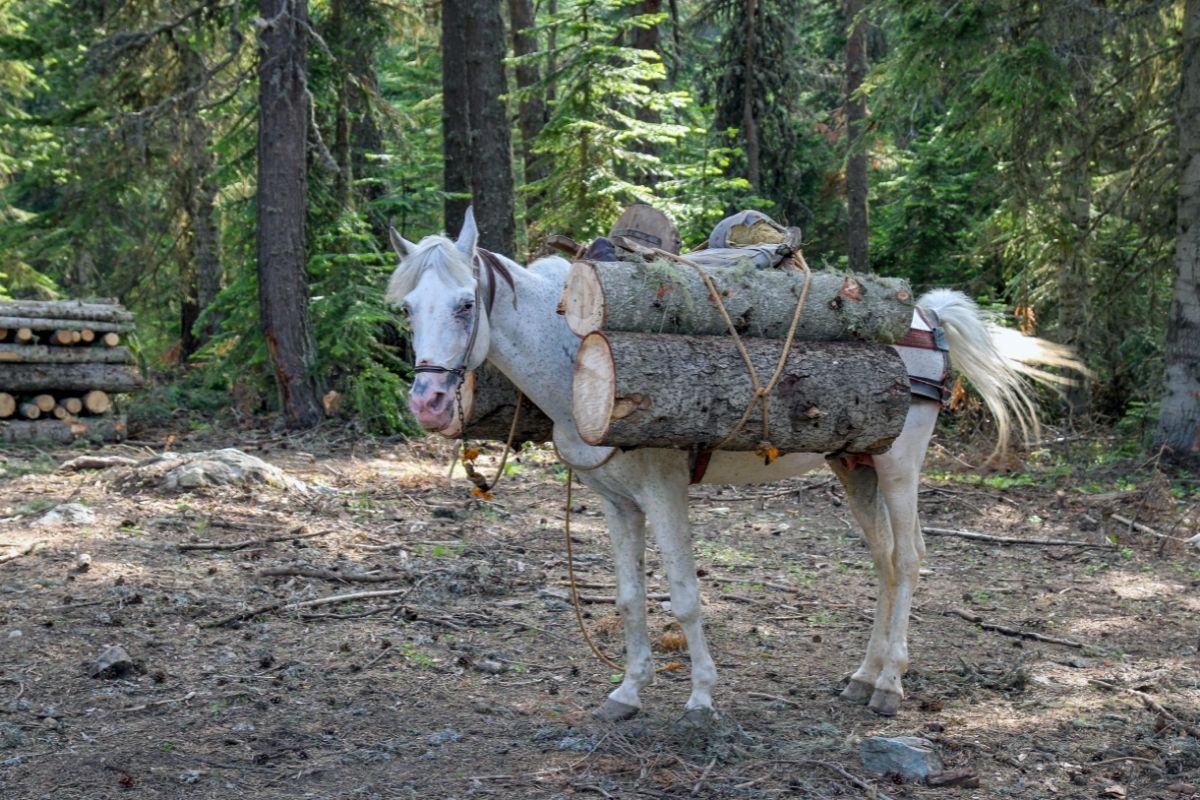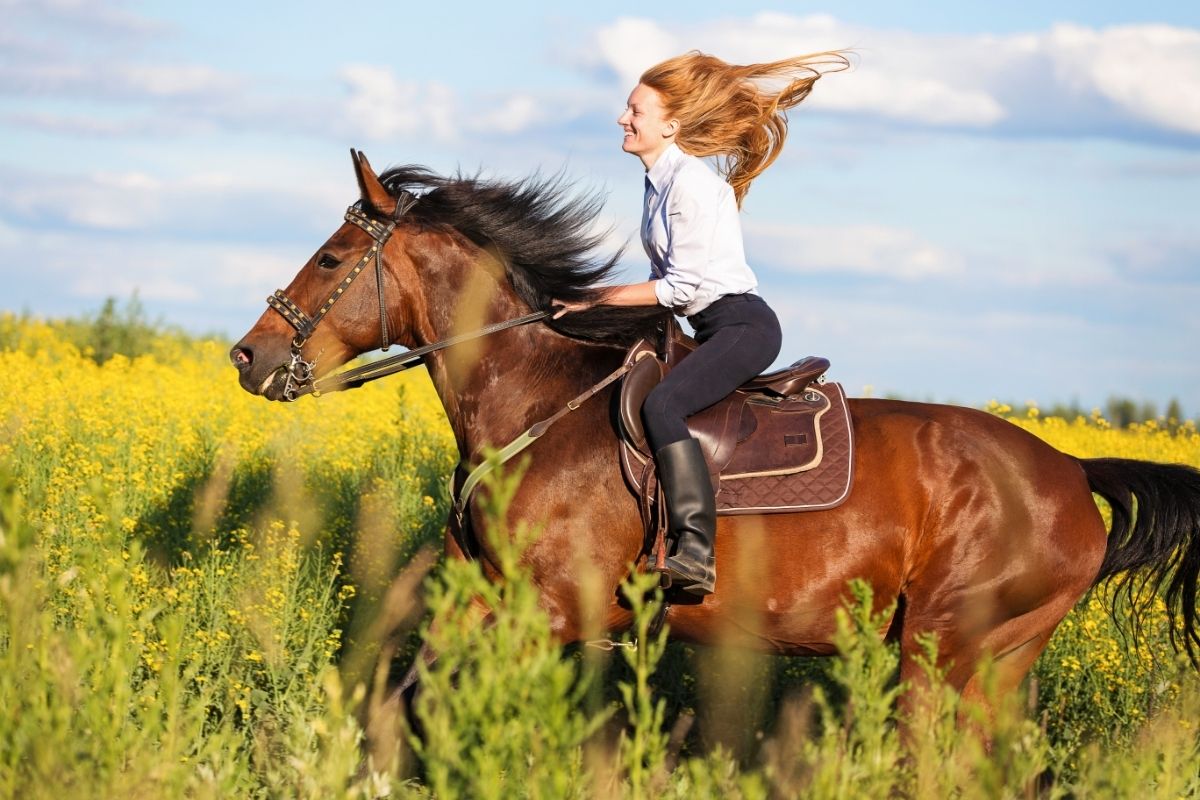You must be wondering how much weight can a horse carry? Or how much weight should a horse be able to carry? This is an important question that anyone who rides horses needs to ask at some point.
Before the invention of motorized vehicles, horses were an integral part of how humans moved about. Horses offered horsepower for transportation and farm work. Since the invention of motorized vehicles, many people today do not understand how heavy it is too heavy to ride a horse!
Here, we will talk about how much weight can a horse carry and how this has changed over time.
Let’s find out more about this critical question!

Horses as Hardworking Stalwarts
We are all familiar with the phrase “the horse as a working animal,” right? Horses have performed laborious human tasks for thousands of years worldwide. Horses have been domesticated for over 6,000 years and used for farming and transportation.
In those days, horses were used as a reliable source of transportation. Heavier and stronger horses were used to pull carriages and carry goods (and people) across long distances.
An average horse weighed about 1764-2205 pounds (800 to 1,000 kilograms) in those days. The weight limit for horseback riding was probably 110-220 pounds (around 50-100 kilograms). The rest of the weight was attributed to their food intake.
In more recent history, horses have been used for sports. In the early 19th century, the average weight of a horse was 816 pounds (370 kilograms). But, since the invention of motorized vehicles, horses have been primarily used for sports and not to carry weight.
How Much Weight Can a Horse Carry (Safely)?
A horse can carry a weight limit of 20% of its body weight. Most horses have a maximum weight limit of around 400 pounds (181.4 kilograms), depending on the breed and conformation.
Theoretically, a horse is physically capable of carrying a person that is 20% of his weight, which means a 2000-pound (907-kilogram) draft horse can carry up to 400 pounds (181.4 kilograms).
The weight capacity depends on many factors, such as its physical condition and health status. Horses with certain physical conditions or health issues may not safely carry as much weight as a healthier horse could.
Horse weight limit also depends on how they are used; for example, a racehorse may not carry weight while a draft horse may have no problem.
Horse Conformation and Weight Carrying Ability
Horse weight carrying ability is determined by its conformation. A horse’s weight carrying ability is directly related to its conformation, which means the weight carrying capacity can be determined based on its physical build.
- Head: A well-proportioned head is essential for weight-bearing capability. A weight-bearing horse needs a broad forehead and wide jaws, which oppose the head’s weight.
- Neck: A horse’s neck should be well laid back and have a good length between the poll and withers. The neck must be strong enough to carry weight without bowing. The shoulder also supports it.
- Chest: A horse’s chest should be broad, deep, and well-muscled to support the weight. The weight carried by a weight-bearing horse is distributed between the forehand and hindquarters, with the weight-bearing muscles in the front of the body supporting more weight than those at the rear.
- Shoulder: The weight of a horse is channeled through the shoulder, which must be solid and muscular.
- Back: A weight-carrying horse’s back should support weight throughout its length without allowing it to sag or dip excessively. Weight-bearing capability is adversely affected by a hollow, sway, roach, or swayed back.
- Hindquarters: The hindquarters should be broad and deep enough to support the weight adequately. They must also be well-muscled to provide the weight-bearing capability.
- Legs: Legs of weight-bearing horses must have the strength to carry the weight. They must have large joints and strong, dense bones with good conformation. They should also be in proportion to the weight-bearing front end. The hind legs must have large joints and strong, dense bones with good conformation.
What Other Factors Determine an Equine’s Weight Carrying Capacity?
The weight carrying ability of a horse can also be affected by the following factors:
Fitness and Condition
The weight carried by a horse is related to its fitness and health. A healthy, well-conditioned horse can carry weight more easily than an unfit horse. A horse must be in excellent health to reach its full carrying capacity.
Horse Breed
A horse’s carrying capacity varies depending on its breed. Horses with short backs and flat bones can’t carry as much weight as horses with lengthy backs and deep, broad bodies.
An Icelandic horse, for example, may comfortably carry up to 22.7% of its body weight, while the Paso Fino horse can safely transport up to 25% of its weight.
Rider’s Fitness and Experience
If a horse is exhausted after working out, an inexperienced rider may easily lose balance as they struggle to get into the correct saddle position. A skilled rider understands how to adjust their body weight so that the horse can keep going without them having to work too hard.
Injury or Disease
Maintaining weight-bearing capability requires a horse to be in good health. A horse may become lame if it suffers an injury, has a disease, or is extremely old and becomes too weak to carry weight well.
Height and Age of Horse
The weight carrying ability also depends on its height and age. Adult horses are usually able to carry weight better than young horses. Young horses and ponies can usually carry weight more easily than tall, mature horses.
Feed Intake and Diet
A weight-carrying horse must also meet its nutritional requirements and eat a healthy and balanced diet. Overfeeding and improper feeding can decrease your horse’s weight carrying capability.
Weight of Rider and Equipment
The weight-carrying capacity of horses can be affected by the weight of your rider and equipment.
Overweight horse riders should consider weight loss to improve their riding experience. It is usually easier for a horse to carry weight when the weight of the rider and equipment is evenly distributed.

Why is it Important to Know a Horse’s Weight Capacity?
Knowing the weight-carrying capacity of horses gives you an insight into how much weight your horse can carry without potentially causing injury to itself.
This knowledge also enables you to safely and comfortably ride with appropriate weight distribution on your weight-bearing horse, which will lessen the chance of losing balance and control as the weight increases.
There are also risks to horses if they are overloaded. Some of the dangers to exceeding weight-carrying capacity may include:
- Sore Muscles: When weight is increased, joints and muscles must work harder to support the horse and rider’s weight. If the horse is overloaded, the muscles have to bear weight beyond what they are used to. This may lead to soreness and delayed recovery.
- Poor Gait: Increased weight may change the way horses move. A horse may not move with its usual gait. It may change how it moves to reduce stress on its body. This can lead to muscle fatigue, lameness, and other weight-related problems.
- Poor Balance: Even weight distribution can affect a horse’s ability to maintain balance. Changes in weight-carrying capability will likely affect weight distribution and how horses respond to weight changes.
- Breathing Difficulties: Horses carry weight by using their respiratory muscles to expand and contract the lungs. Horses that are overloaded often breathe more rapidly than usual, which can lead to respiratory diseases or disorders.
Your Horse Weight Capacity Chart
The weight limit for horse riding varies according to height, weight, age, sex, and breed. The weight chart below shows the weight-carrying capacity for horses based on weight and breed.
| Breed | Weight (pounds/kilograms) | Carrying Capacity (pounds/kilograms) |
| Andalusian | 1000 to 1300 pounds (453.6-589.7 kilograms) | 200 to 260 pounds (90.7-117.9 kilograms) |
| Appaloosa | 1000 to 1300 pounds (453.6-589.7 kilograms) | 200 to 600 pounds (90.7-272.2 kilograms) |
| Arabian | 800 to 1000 pounds (362.9-453.6 kilograms) | 160 to 200 pounds (75.6-90.7 kilograms) |
| Cleveland Bay | 1200 to 1500 pounds (544.3-680.4 kilograms) | 240 to 300 pounds (108.9-136 kilograms) |
| Clydesdale | 1600 to 1800 pounds (725.7-816.5 kilograms) | 320 to 360 pounds (145-163.3 kilograms) |
| Dutch Warmblood | 1200 to 1300 pounds (544.3-589.7 kilograms) | 240 to 260 pounds (108.9-117.9 kilograms) |
| Icelandic Horse | 730 to 840 pounds (331.1-381 kilograms) | 165 to 190 pounds (74.8-86.2 kilograms) |
| Miniature Horse | 150 to 350 pounds (68-158.6 kilograms) | 30 to 70 pounds (13.6-31.8 kilograms) |
| Mule | 800 to 1000 pounds (362.9-453.6 kilograms) | 200 to 250 pounds (90.7-113.4 kilograms) |
| Paso Fino | 700 to 1000 pounds (317.5-589.7 kilograms) | 175 to 250 pounds (79.4-113.4 kilograms) |
| Quarter Horse | 1000 to 1300 pounds (453.6-589.7 kilograms) | 200 to 260 pounds (90.7-117.9 kilograms) |
| Racehorse | 900 to 1100 pounds (408-499 kilograms) | 180 to 220 pounds (81.6-99.8 kilograms) |
| Shire | 1700 to 2700 pounds (771.1-1224 kilograms) | 340 to 540 pounds (154.2-244.9 kilograms) |
| Standardbred | 1000 to 1320 pounds (453.6-598.7 kilograms) | 200 to 264 pounds (99.7-119.7 kilograms) |
| Thoroughbred | 1000 to 1300 pounds (453.6-589.7 kilograms) | 200 to 260 pounds (90.7-117.9 kilograms) |
Which Horse Breeds are Best for Heavy Riders?
Large horse breeds for riding are ideal weight-carrying horses for people who weigh 250 pounds (113.4 kilograms) or more. A horse does not always have to be taller, but it must have a solid structure.
Horses with a sturdier build can carry more weight than refined, lean breeds with a flatter cannon bone circumference. The cannon bone’s circumference is frequently a sign of how robust a horse is.
Horses with larger cannon bones can generally carry more weight without height being a concern: the larger the horse’s bones, the less potential pain for riding or working. Some of the breeds that are best for riding include:
Friesian
This breed weighs 1,200-2,000 pounds (544.3 to 907.2 kilograms). It is a robust breed with a heavier build.
This breed is suitable for riding at any age and is known to be calm, gentle, and intelligent.
The Friesian breed can safely carry a rider weighing up to 250 pounds (113.4 kilograms) with 20 pounds (9 kilograms) of saddle equipment without any trouble.
Clydesdale
This breed stands 16 to 18 hands high and weighs between 1600-1800 pounds (725.7 to 816.5 kilograms). It is muscular with a heavy bone structure. It can be bay in color.
Clydesdales may also be wonderful riding horses despite their reputation as driving horses. The cold-blooded horse breed is kind and reliable, riding horses with pleasant personalities.
A Clydesdale can safely carry a rider weighing up to 280 pounds (127 kilograms) riding with saddle equipment of 40 pounds (18.1 kilograms).
Shire
Shires are a large breed of horse that is powerful and serene. Though they aren’t typically thought of as riding horses, they can be excellent partners in the saddle.
The breed weighs 1,700-2,000 pounds (771.1 to 997.2 kilograms) on average and can carry a rider who weighs up to 300 pounds (136.1 kilograms) riding with a saddle that weighs up to 50 pounds (22.7 kilograms).
Shires are athletic riding horses and are well-suited to riding at any age. They are gentle, calm, and intelligent riding partners, making them well-suited mounts for active riders.
Irish Draught
This breed weighs from 1,300 to 1,400 pounds (589.7 to 635 kilograms) or more. The horse is muscular with a strong body. It can be gray, bay, or chestnut.
The Irish Draught horse breed is an excellent riding horse for people who weigh over 250 pounds (113.4 kilograms) riding with saddle equipment that weighs no more than 20 pounds (9.1 kilograms).
This active riding horse breed is known for its sensible attitude and stamina. It is also a riding horse for all ages, making it well-suited to riding at any age.
Percheron
The Percheron is a draft breed of a riding horse that is muscular and heavy-boned. The breed weighs 1,800-2,000 pounds (816.5 to 907.2 kilograms).
Though most people do not consider riding horses, heavy riders weighing around 320 pounds (145.1 kilograms) find riding a Percheron horse a pleasurable riding experience.
This riding horse is excellent for riding at any age and has a calm and friendly personality.
American Cream Draft
Although the American Cream Draft is not a popular horse breed, they have a loyal following. These riding horses are strong, docile riding partners.
The breed weighs 1,600-1,800 pounds (725.7 to 816.5 kilograms). It is muscular with a calm disposition. This riding horse is generally pale cream or golden in color and is America’s only native draft breed.
The American Cream Draft breed is an excellent riding partner for around 280 pounds (127 kilograms) riding with saddle equipment that weighs no more than 40 pounds (18.1 kilograms).
Cleveland Bay
Cleveland Bay is a riding horse breed with a pleasant temperament and good temper. They have a long history in England as riding horses for people of all ages and riding abilities.
The breed weighs 1,400 pounds (635 kilograms) or more on average, with a maximum weight of 1,500 pounds (680.4 kilograms).
This riding horse is an excellent riding partner for people who are around 260 pounds (117.9 kilograms) riding with saddle equipment that weighs no more than 20 pounds (9 kilograms).
The riding horse is intelligent, has a calm temperament, and has good stamina. It also has an excellent disposition making it perfect for riding at any age.

Key Highlights
While riding horses are typically not thought of as riding partners for heavy riders, some breeds can accommodate them.
However, it is always good to avoid riding double on horseback with a horse, as riding at a trot for long periods is not healthy. The riding horse breeds best suited to riding double on horseback are Percheron, Cleveland Bay, Shire, American Cream Draft, Irish Draught, and Spotted Draft Horse.
Did you find this information helpful? We’d like to hear from you! Let us know in the comments section.
